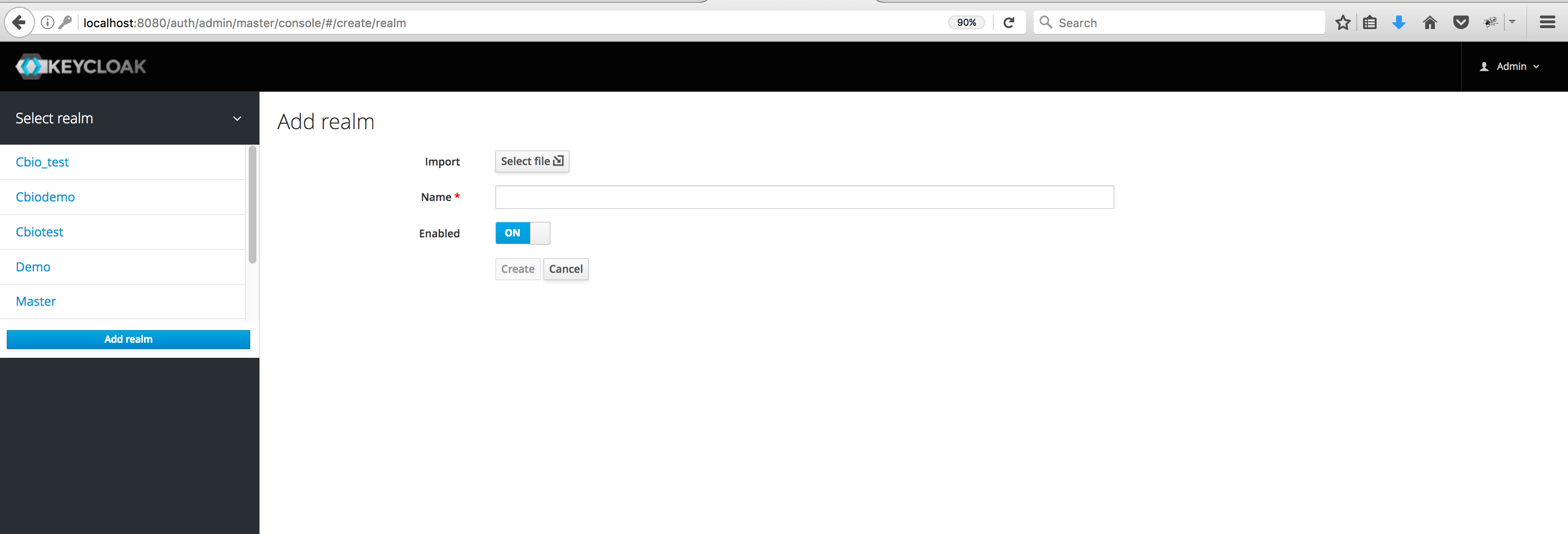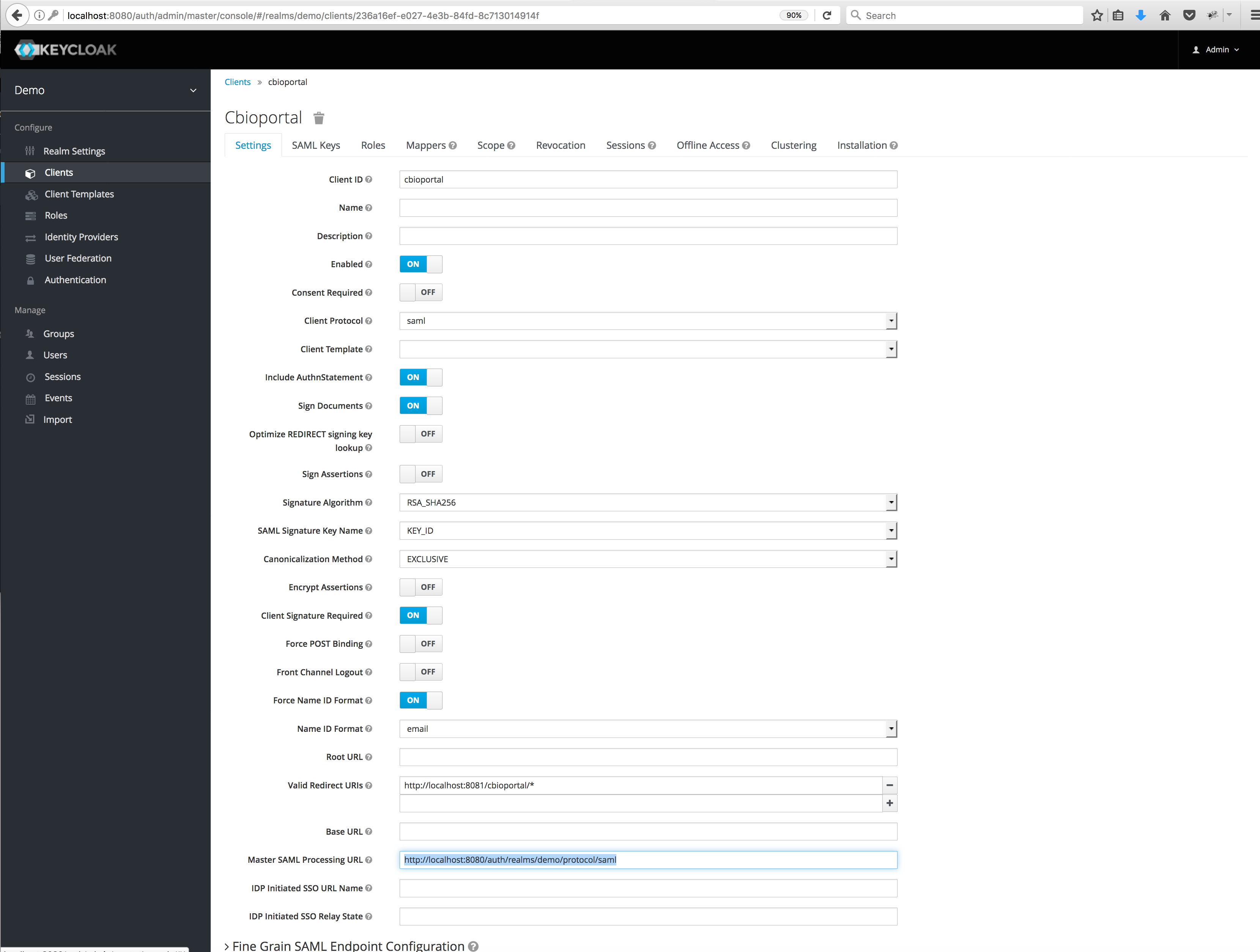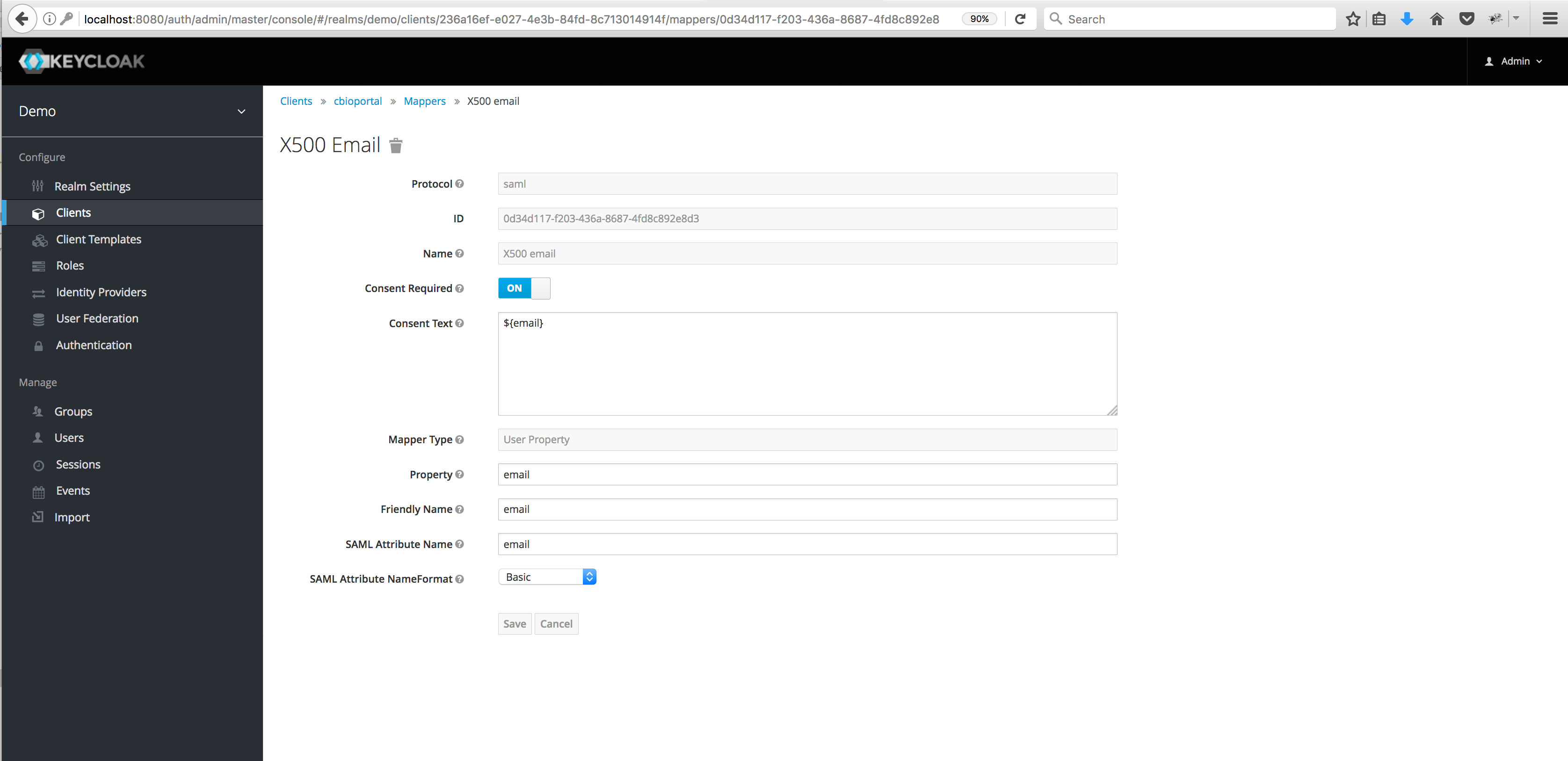Authenticating and Authorizing Users via Keycloak
Introduction
The cBioPortal includes support for Keycloak authentication. Keycloak can function as an Identity Provider (IDP) for cBioPortal. This document explains why you might find Keycloak authentication useful for storing your user login information outside the cBioPortal database. It also shows you how to configure Keycloak to communicate with your instance of cBioPortal using SAML (Security Assertion Markup Language).
Please note that configuring your local instance to use Keycloak authentication requires a Keycloak server to be set up. For details on how to set up a Keycloak server, please read online document at https://www.keycloak.org/docs/latest/server_installation/index.html.
This document focuses mainly on the steps to configure Keycloak for authenticating cBioPortal users.
To skip to the authorization section see: authorization with Keycloak. Or continue reading to learn how to integrate Keycloak with cBioPortal.
Why Keycloak?
Keycloak is an open source identity and access management solution. It has a built-in RDBM system to store login information. It can help build a security layer on top of the cBioPortal web application.
Keycloak boils down to three simple terms:
- realm: A realm secures and manages security metadata for a set of users, application, and registered auth clients.
- client: Clients are entities that can request authentication of a user within a realm.
- role: Roles identify a type or category of user. Keycloak often assigns access and permissions to specific roles rather than individual users for a fine-grained access control.
Keycloak offers three types of roles:
- Realm-level roles are in global namespace shared by all clients.
- Client roles have basically a namespace dedicated to a client.
- A composite role is a role that has one or more additional roles associated with it.
How does Keycloak SAML Authentication work?
Keycloak supports both OpenID-Connect and SAML authentication. When you use SAML authentication, the Keycloak server exchanges XML documents with a web application. XML signatures and encryption are then used to verify requests from the application.
Configure Keycloak to authenticate your cbioportal instance
- Log in to your Keycloak Identity Provider, e.g. http://localhost:8080/auth, as an admin user. :warning: when setting this up on something else than localhost (e.g. production), you will need to use/enable https on your Keycloak server. For simplicity, the rest of the documentation below continues on http://localhost.
- Hover over the top-left–corner drop down menu (titled ‘Master’) to create a new realm.
 Please note if you are logged in the master realm, this drop-down menu lists all the realms created. The last entry of this drop-down menu is always Add Realm. Click this to add a realm. Then type ‘cbioportal’ in the name field and click the Create button.
Please note if you are logged in the master realm, this drop-down menu lists all the realms created. The last entry of this drop-down menu is always Add Realm. Click this to add a realm. Then type ‘cbioportal’ in the name field and click the Create button. - To create a SAML client, go to the Clients item in the left menu. On this page, click the Create button on the right. This will bring you to the Add Client page.
- Enter a Client ID for the client, e.g. ‘cbioportal’, this will be the expected
issuervalue in SAML requests sent by the application. - Select saml in the Client Protocol drop down box.
- Enter
http://localhost:8081/cbioportal/samlin the Client SAML Endpoint textbox, this is the URL that the Keycloak server will send SAML requests and responses to. Then click the Save button; this will take you to the client page below.
- Enter a Client ID for the client, e.g. ‘cbioportal’, this will be the expected

- Choose email as your Name ID Format.
- Next, enter a pattern for Valid Redirect URIs that Keycloak can use upon a successful authentication, e.g.
http://localhost:8081/cbioportal/*. :information_source: notice that you can add multiple URLs in this field. You could use this in some cases to support the URLs with and without port (e.g. if tomcat is running on port80and you want to allow bothhttp://localhost:80/cbioportal/*andhttp://localhost/cbioportal/*as redirect URLs). - Set Force POST Binding and Front Channel Logout to OFF and Force Name ID Format to ON.
- Expand the subsection Fine Grain SAML Endpoint Configuration and set Logout Service POST Binding URL to
http://localhost:8081/cbioportal/saml/logout. - Leave everything else as it is and click Save.
Map SAML Assertion Attributes
To specify attributes included in the SAML assertion, simply click on the Mappers tab, and add mappers using the Add Builtin and Create buttons. Make sure you add at least:
- the built-in User Property mapper named X500 email and
- a Role list-type attribute using the word roles as its Role attribute name.

Edit the email attribute to use the word email as the SAML Attribute Name.

Finally, head to the Scope tab for the client and switch off Full Scope Allowed, to ensure that only those roles relevant to a particular cBioPortal instance are listed in assertions sent to the instance, and not any other roles tracked in Keycloak.
Export configuration for cBioPortal
- Next, navigate to the Installation tab for the same client.
- Select SAML Metadata IDPSSODescriptor as the Format Option and click the Download button.
- Move the downloaded XML file to
portal/src/main/resources/
Create a signing key for cBioPortal
Use the Java ‘keytool’ command to generate keystore, as described
here
on the page about SAML in cBioPortal:
keytool -genkey -alias secure-key -keyalg RSA -keystore samlKeystore.jks
Install the generated JKS file to portal/src/main/resources/
In order to let Keycloak know that it can trust the holder of this
key, you’ll need to import the key’s certificate into Keycloak. In the
Keycloak admin screen about the cbioportal client, head to the
SAML Keys tab and click the Import button. Select the JKS
archive format, specify the key alias secure-key and type the store
password apollo1 (not the private key password, as Keycloak only
needs to know the certificate), and select the file you just
installed. Keycloak may not give an indication of successful
completion, but when navigating to the SAML Keys tab again you
should now see the certificate and no private key.
Modifying configuration
- Within the portal.properties file , make sure that this line is present:
app.name=cbioportal - Then, modify the properties under the comment
# authentication. In particular, see the options listed in the example below:
filter_groups_by_appname=false
saml.sp.metadata.entityid=cbioportal
saml.idp.metadata.location=classpath:/client-tailored-saml-idp-metadata.xml
saml.idp.metadata.entityid=http://localhost:8080/auth/realms/cbioportal
saml.keystore.location=classpath:/samlKeystore.jks
saml.keystore.password=apollo1
saml.keystore.private-key.key=secure-key
saml.keystore.private-key.password=apollo2
saml.keystore.default-key=secure-key
saml.idp.comm.binding.settings=defaultBinding
saml.idp.comm.binding.type=
saml.idp.metadata.attribute.email=email
saml.idp.metadata.attribute.role=roles
saml.custom.userservice.class=org.cbioportal.security.spring.authentication.keycloak.SAMLUserDetailsServiceImpl
# global logout (as opposed to local logout):
saml.logout.local=false
saml.logout.url=/
Obtain user identities
Optional: create users in Keycloak
To create a user, click on Users in the left menu bar. This menu option brings you to the user list page. On the right side of the empty user list, you should see an Add User button. Click that to start creating your new user.

Optional: integrate company-wide authentication services
Keycloak can read credentials from existing user databases, for instance over LDAP. This is referred to as user federation. Keycloak can also allow authentication by an external login form altogether using a protocol such as SAML, it calls this identity brokering. In either case, Keycloak acts as a proxy between your user directory and cBioPortal, deciding which authorities to grant when telling cBioPortal that the user has authenticated.
Please refer to the Keycloak documentation on user federation and identity brokering for more information on how to integrate Keycloak with your local LDAP or SAML service.
Federate LDAP/AD user directories
Some notes on user federation using LDAP/Active Directory:
By specifying the Vendor of your LDAP server, Keycloak will choose sensible defaults for the required objectClasses and attributes of your user entries. Apart from the Dedicated Name of the tree in which to search for users and the DN and password that Keycloak should use to bind to the server, make sure to specify the following Custom User LDAP Filter to ensure that only user entries that have an email address are considered:
(mail=*)
When using LDAP to load users from your institute’s user directory,
you will most likely want Keycloak to refrain from trying to
synchronise changes in user details back to the central directory. You
should set Edit Mode to READ_ONLY, as the alternative UNSYNCED
would mean that users can be changed in the Keycloak database once
imported from LDAP, and start diverging. Also disable Sync
Registrations unless you want Keycloak to add new users to the LDAP
store.
Do turn on Import Users to make Keycloak remember users after the first login, if you want to be able to assign non-default roles. If the LDAP tree holding your users is large and you do not want to import all users into Keycloak, make sure to disable Periodic Full Sync and Periodic Changed Users Sync.
Authorization with Keycloak
Create roles to authorize cBioPortal users
The roles you assign to users will be used to tell cBioPortal which studies a user is allowed to see.
To create a role, head to the Roles tab that is displayed along
the top while configuring the cbioportal client – this tab is not
the link of the same name in the left sidebar. Click the Add
Role button. Enter a name (e.g. brca_tcga_pub) and description
for the role and hit the Save button.

Groups
Keycloak allows you to create Groups for easy mapping of multiple
studies to multiple users. One can, for example, make a Keycloak group
with name PUBLIC_STUDIES and add all the individual Keycloak roles
corresponding to public studies to this group. It is also possible to
configure a group to be “default” in Keycloak, meaning new users are
automatically added to this group when logging in for the first time.
Alternatively, the Keycloak roles can correspond to the groups specified in the metadata files of studies instead of corresponding to individual study identifiers. Although this will result in less roles that need to be added and maintained in Keycloak, it does result in group configuration being spread over both Keycloak and meta study files.
Assign roles to users
Next, assign roles to users. Head to Users in the left sidebar, find a user (users from external providers should be known to Keycloak after they have logged in for the first time), click the ID and open the Role Mappings tab for that user. Select the cbioportal client in the dropdown under Client Roles, and use the Available Roles selection and its Add selected button to assign client roles to this user.

To automatically assign roles to all users when Keycloak first sees them, the Roles pane accessed from the left sidebar has a Default Roles tab. The interface for assigning roles here is much the same as the one for assigning roles to individual users.
Doing a Test Run
Rebuild the WAR file and follow the Deployment with authentication
steps using authenticate=saml.
Then, go to: http://localhost:8081/cbioportal/.
If all goes well, the following should happen:
- You will be redirected to the Keycloak Login Page.
- After authenticating, you will be redirected back to your local instance of cBioPortal.
If this does not happen, see the Troubleshooting Tips below.
Troubleshooting
Logging
Getting this to work requires many steps, and can be a bit tricky. If you get stuck or get an obscure error message, your best bet is to turn on all DEBUG logging.
This can be done via src/main/resources/log4j.properties. For example:
# Change INFO to DEBUG, if you want to see debugging info on underlying libraries we use.
log4j.rootLogger=DEBUG, a
# Change INFO to DEBUG, if you want see debugging info on our packages and spring security packages.
log4j.category.org.mskcc=DEBUG
log4j.logger.org.springframework.security=DEBUG
Then, rebuild the WAR, redeploy, and try to authenticate again. Your log file will then include hundreds of SAML-specific messages, even the full XML of each SAML message, and this should help you debug the error.